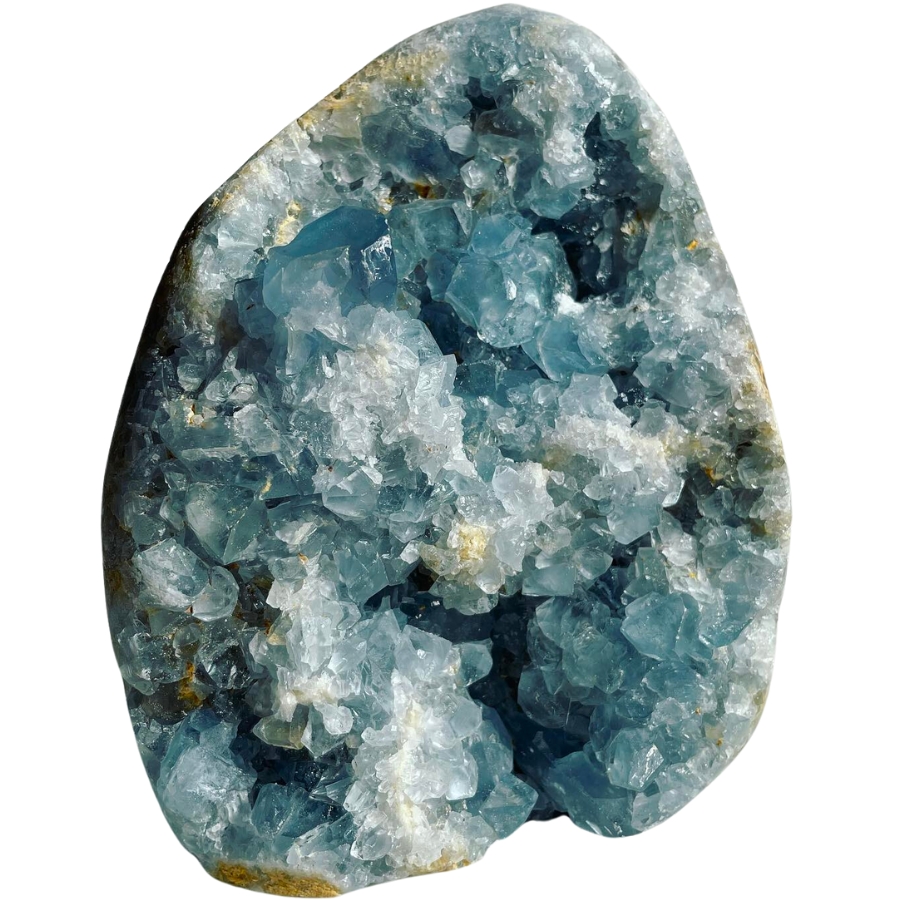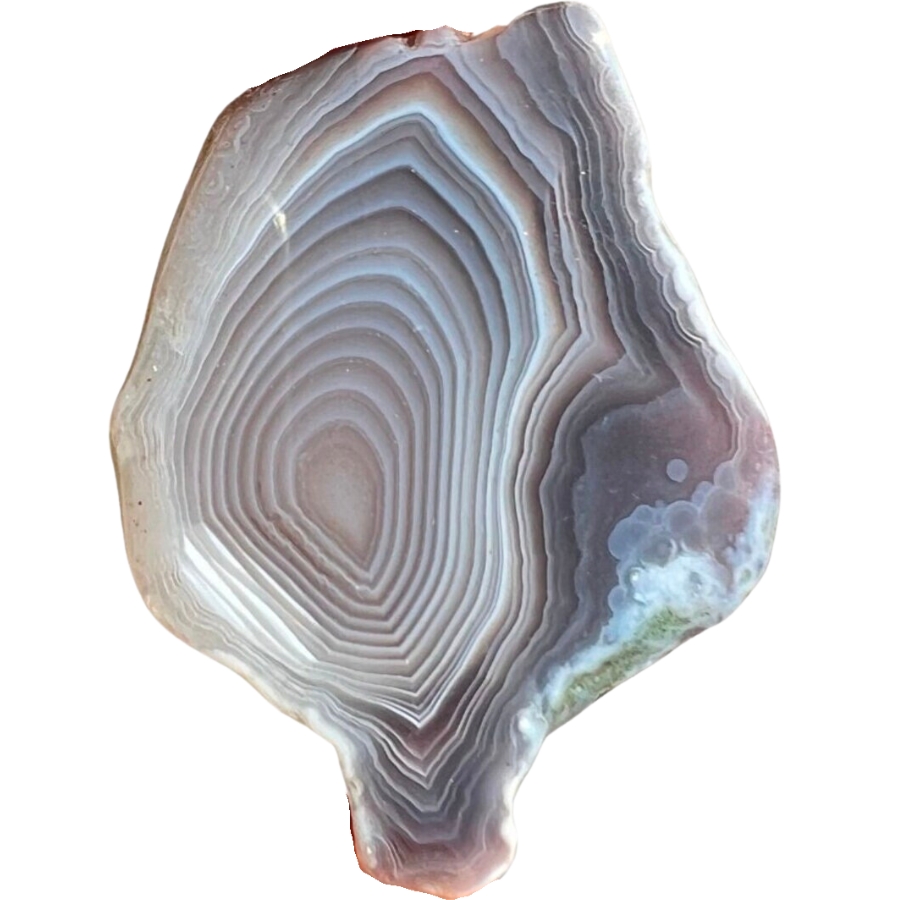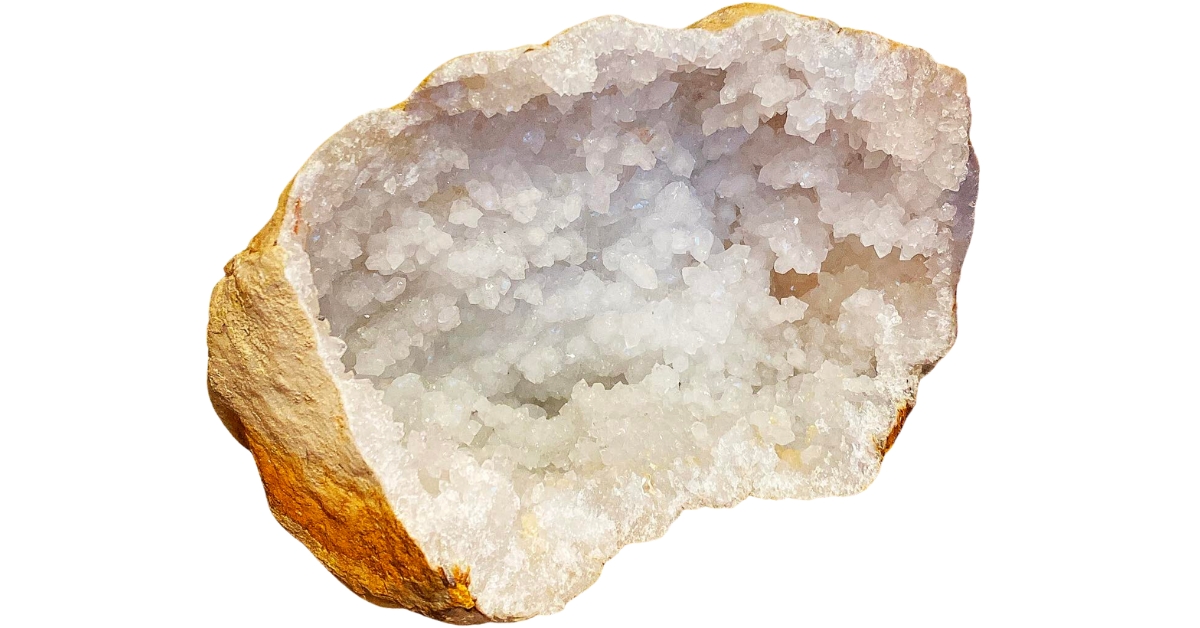Agate and geode are two fascinating rock formations that capture the imagination of many rock enthusiasts. While they may seem different at first glance, they share a special connection that makes them even more intriguing.
Imagine holding a piece of history in your hands, a treasure that’s been forming for millions of years. That’s the allure of these two natural wonders. But if you compare agate vs geode, you’ll realize just how distinct they are from one another.
In this article, we’ll dive into the fascinating world of agate and geode. We’ll explore how they’re alike and how they differ, uncovering the secrets that make each one special. Let’s get started!
The Major Differences
Some people mistake agates for geodes and vice versa. If you’re one of them, below are the notable differences between agate and geodes that you can look for when distinguishing them:
Color – Agate often has bands and patterns of colors.

Agate and geode are like nature’s own rainbow. They both show off an amazing range of colors but in their own unique ways.
Think of agate as the artist of the rock world, painting layers of colors in stripes, bands, and patterns. These can be anything from reds and oranges to blues and greens, often mixed in stunning combinations.
Now, imagine opening a surprise box, and that’s what a geode is like. From the outside, it might not look like much, usually gray or brown and kind of rough. But when you crack one open, it’s a whole different story.
Inside, you find crystals that can be clear, white, purple, or even blue. The crystals are usually quartz, but sometimes you get other minerals that add a splash of color.
Luster – Geode’s inside often has a glassy luster.

Luster is like the shine or sparkle you see on a rock, and it tells us a lot about how light plays with agate and geode.
Agate’s glow can be waxy or shiny. When it’s in its natural state, it might not look super shiny. But once it’s polished, it shines bright and shows off all its colors and patterns.
On the other hand, a geode has crystals inside that sparkle like little stars. The crystals, often made of quartz, have a glassy luster. This means they’re shiny and reflect light like a mirror or a glass window.
The cool part is that each crystal inside a geode catches the light in its own way, so when you move a geode around, it sparkles and glitters.
Crystal Structure – Agate has a trigonal crystal system.

Crystal structure is all about looking at how the tiny bits that make up a rock are arranged. It’s like how the bricks in a building are put together in a certain way. Comparing geode vs agate, you’ll see how different they are in this aspect.
Agate is made up of small crystals that you can’t see without a microscope. These are packed tightly together. This is what gives agate its strength and allows it to be polished to a high shine.
Geodes, on the other hand, have bigger crystals that you can see and feel. These can be different sizes, but they’re usually much bigger than the ones in agate.
The gradual growth of the crystals happens in an open space inside the rock, which is why they have room to grow big and form those awesome shapes.
Composition – Geode’s composition varies depending on the minerals inside it.

Composition is like the recipe that makes up a rock. It’s all about what materials are in there and how they come together.
Agate is mostly made of silicon dioxide. There are also tiny bits of other minerals mixed in. These extra minerals can be all sorts of colors, and that’s what makes each piece of agate unique and beautiful with its different patterns and colors.
Geodes, meanwhile, are a bit of a mix. Its outside is usually made of a kind of rock like limestone or basalt. But inside, the crystals are often quartz, just like in agate.
However, it can also have other minerals like calcite or amethyst. These different minerals can make the inside of a geode look like a treasure chest of gems.
Formation – Agate forms from silica-rich water.

Agate forms when water with minerals in it gets into cracks or spaces in rocks. Over time, these minerals start to settle and harden.
This hardened material is full of silica, which is the main ingredient in quartz. As this silica-rich water keeps flowing in, it leaves layer after layer of minerals. These layers pile up and eventually harden into agate.
In comparing agate vs geode, you’ll see that the latter starts its journey a bit differently. It begins in hollow spaces inside rocks. These spaces can be in volcanic rocks or sedimentary rocks like limestone.
Then, water with minerals in it seeps into these hollow spaces. Just like with agate, the water leaves minerals behind. But in geodes, the minerals have more room to spread out and grow into bigger crystals.
Hardness – Geode’s hardness is based on the different minerals it has.

Hardness is how well a rock can resist getting scratched, and it’s pretty important when we talk about the differences between agate and geode.
Agate is known for being quite hard. It scores around 6.5 to 7 on the Mohs Scale of Hardness, which goes from 1 (softest) to 10 (hardest). With agate being around 7, it means it’s pretty resistant to scratches and wear.
That’s why it’s so popular for things like jewelry and decorations— it can handle being worn or handled without getting all scratched up easily.
As for a geode, its hardness depends a lot on what kind of crystals are inside it. But the outer layer of a geode, which is the rock part, might be softer or harder depending on what type of rock it is.
Density – Agate feels solid and heavy for its size.

Density is all about how much stuff is packed into a space. It’s like comparing a backpack full of books to one that’s just got a few.
Agate is pretty dense, which means it has a lot of material packed tightly together. This tight packing is because it forms from layers of minerals, mainly quartz, that pile up and press together over time.
Geode, meanwhile, is kind of like a surprise egg. On the outside, it’s just plain rocks, but inside, it’s hollow with crystals. This hollow space means it isn’t as dense as agate.
So, when you hold a piece of agate, it feels solid and heavy for its size. But having a geode is like having a box that looks full but is actually mostly air inside.
Price – Large and beautiful geode specimens can be quite valuable.

When we talk about the price of rocks like agate and geode, it’s a bit like shopping for clothes. Some clothes are more expensive because of their brand or how they look, and the same goes for these two natural treasures.
The price of agate depends on factors like how pretty it is, its colors, and the patterns it has. Some agates are really unique and have amazing designs, which can make them more valuable.
Plus, if it’s cut and polished to be used in jewelry or decorations, that can add to its price, too.
As for geodes, small ones might not cost much. But bigger geodes, especially those with nice crystals inside, can be more expensive. The value of a geode can go up depending on its size and the types of crystals inside it.
The Similarities
Despite having more differences, geode and agate share significant similarities, too. Being familiar with these similarities is also important if you want to understand the individuality of these two natural wonders.
Streak – Both agate and geode have white streaks.

When you rub a rock on a piece of unglazed porcelain, called a streak plate, it leaves a powdery line. This line, or streak, shows the true color of the rock.
Both agate and geode usually have the same streak color, which is white. It doesn’t matter what color the agate or the geode is on the outside, the streak is almost always white.
This is because the main mineral in both of these rocks is usually quartz, and quartz leaves a white streak.
So, imagine you have a bright red piece of agate and a geode with purple crystals inside. If you rubbed them both on a streak plate, they would both leave a white line.
Cleavage – Geode and agate do not have cleavage and fracture conchoidally.

Cleavage in rocks is all about how they break. It’s not about them falling apart, but how they split along certain lines or planes.
When we look at agate and geode, we find something they have in common: neither of them has cleavage. Instead, they break in a different way called a conchoidal fracture.
Imagine breaking a piece of glass. Do you know how it makes those curved, shell-like shapes? That’s what conchoidal fracture is like.
When you try to break agate and geode, they don’t split along straight, flat lines. Instead, they crack and break in curved, uneven patterns. It’s like snapping a thick piece of candy. It doesn’t split neatly; it just kind of shatters in all directions.
Magnetism – Neither agate nor geode is magnetic.

Magnetism measures the rock’s ability to stick to a magnet. Some are magnetic and stick to magnets well, but some are not.
Here’s the thing about agate and geode: they’re usually not magnetic. This means if you held a magnet up to them, they wouldn’t stick to it. It’s like trying to stick a magnet to a plastic toy— nothing happens.
The reason geode and agate aren’t magnetic is because of what they’re made of. Most of the time, they’re made from minerals like quartz, which don’t have any magnetic properties.
It’s like how wood or glass aren’t magnetic. These minerals just don’t have the right stuff in them to be attracted to magnets.
Fluorescence – Geode and agate can both fluoresce.

Fluorescence happens when a rock lights up under ultraviolet light, which is a special kind of light that we can’t see with our eyes.
Agate and geode can both be fluorescent, which means they can glow in cool colors under this special light. Not all agates and geodes will glow, though, but some of them have this awesome ability.
Under normal light, they look like regular rocks. But under ultraviolet light, they can light up in bright colors like green, blue, or even red.
The reason some agates and geodes can glow is because of certain minerals in them. These minerals react to the ultraviolet light and make the rock light up.
Conductivity – Both agate and geode are poor conductors.

Conductivity is all about how well something can carry electricity. Think of it like a wire that lets electricity flow through it to turn on a light.
Agate and geode are similar in this way: they’re both not very good at conducting electricity. It’s like trying to use a piece of rubber as a wire: electricity just doesn’t want to go through it.
The reason agate and geode aren’t good conductors is because of what they’re made of.
They’re mostly made of minerals like quartz, and quartz doesn’t let electricity pass through it easily. It’s like a roadblock for electricity. This is why you can’t use agate or geode to make electrical wires or anything like that.
Location – Geode and agate are both found in areas with volcanic history or sedimentary deposits.

The best places to find agate are areas with volcanic rocks and sedimentary rocks like limestone. And the great news is these are also where you can find geodes near you.
These places are where the earth has been really active, either spewing out lava or laying down layers of rock over a long time.
In these areas, over time, water with minerals in it seeps into the rocks. This water starts making cool changes, like forming agate in the cracks and spaces or creating geodes in hollow areas inside the rocks.
You can find both agate and geode in lots of places around the world. From the deserts of Brazil to the shores of the Great Lakes in North America, these rocks have settled down in different spots where the conditions are just right.
The Easiest Ways To Tell Them Apart

Knowing the similarities and differences between agate and geode will help you a lot in identifying them. But if you need more guidance in telling one from the other, here are a few practical tips you can do in the field:
Do a visual inspection
When you’re trying to figure out if a rock is an agate or a geode, looking closely at its appearance can give you important clues.
Agates usually have colorful bands or stripes on their surface, like a pattern made of different colors. These colors can be white, gray, brown, red, or blue, and they’re often arranged in layers.
On the other hand, geodes don’t have distinct bands. Instead, they have a more irregular shape with a rough texture on the outside. They have bumps and lumps on their surface, and they might not have the same clear patterns that agates do.
Try a sound test
Another way to figure out if a rock is an agate or a geode is by listening to the sound it makes when you tap on it. This is called a sound test.
When you tap on an agate with something hard like a coin or a key, it usually makes a sharp, ringing sound. That’s because they are dense and solid, so the sound bounces off them like it would off a solid object.
In comparison, when you tap on a geode, it often makes a duller, more hollow sound. This is because they have empty spaces or cavities inside them, so the sound doesn’t bounce off them in the same way it does with agates.
Crack it open
Cracking open a rock can be a bit more advanced, but it can also be a helpful way to tell if it’s an agate or a geode.
When you crack open an agate, you’ll usually see a smooth, polished surface inside. This surface often has distinct bands or layers of colors, like what you saw on the outside of the rock.
But when you crack open a geode, you’ll find a hollow cavity inside instead of a solid surface. This cavity is usually lined with crystals or mineral deposits, which can sparkle and shine in the light.


